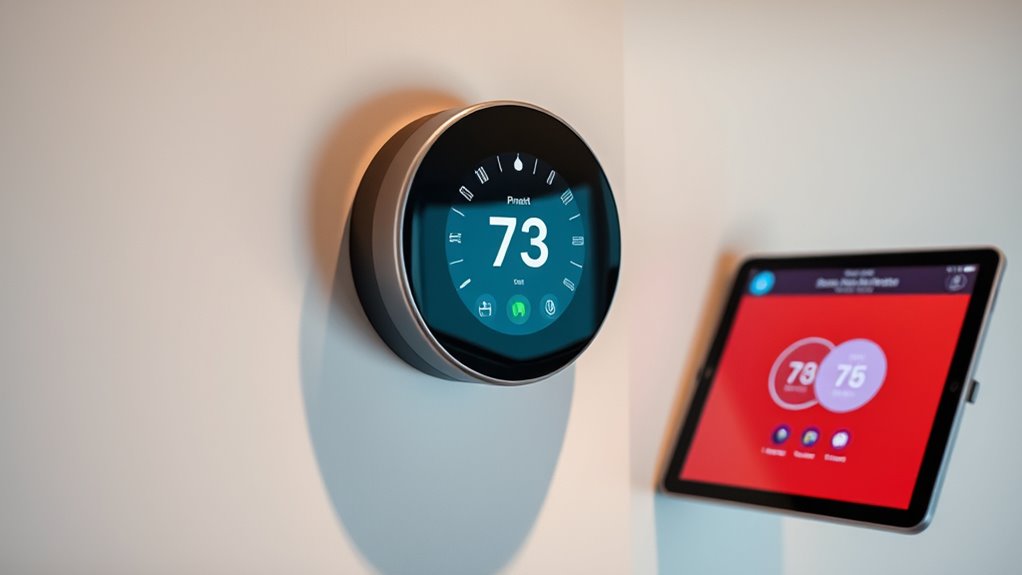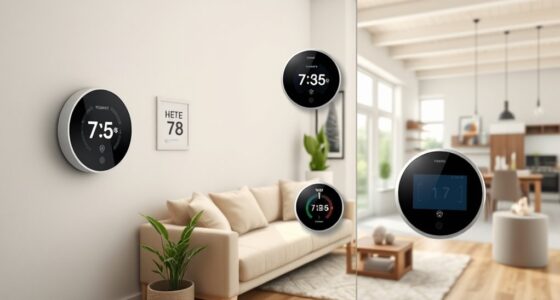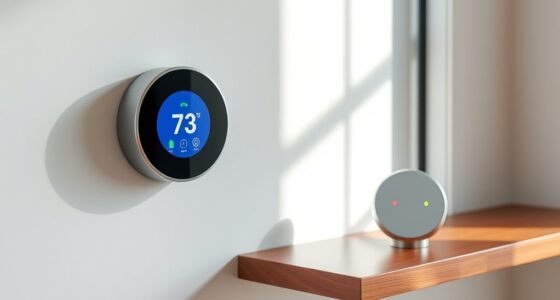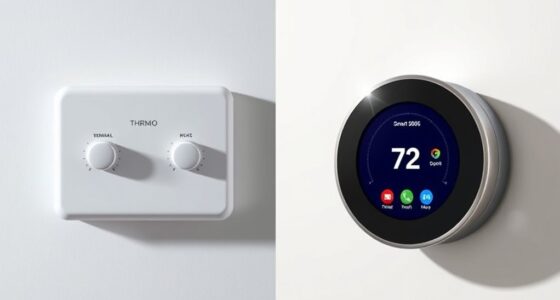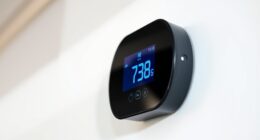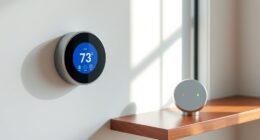When choosing a smart thermostat for your short-term rental, focus on features like programmability, remote control, and compatibility with your HVAC system. Look for models that learn guests’ preferences, use geofencing to save energy when unoccupied, and offer easy-to-use controls for both you and visitors. Voice control options and energy reports can boost convenience and efficiency. Keeping these factors in mind helps elevate guest comfort and reduce costs—plus, there’s more to discover if you keep exploring.
Key Takeaways
- Ensure compatibility with your existing HVAC system for seamless integration and optimal energy efficiency.
- Prioritize features like remote control, geofencing, and learning preferences to enhance guest comfort and simplify management.
- Select models with user-friendly interfaces and voice control options for easy guest and host operation.
- Consider energy reports and automation capabilities to monitor usage and optimize utility costs over time.
- Evaluate long-term benefits such as improved property appeal, increased occupancy, and sustainable energy management.
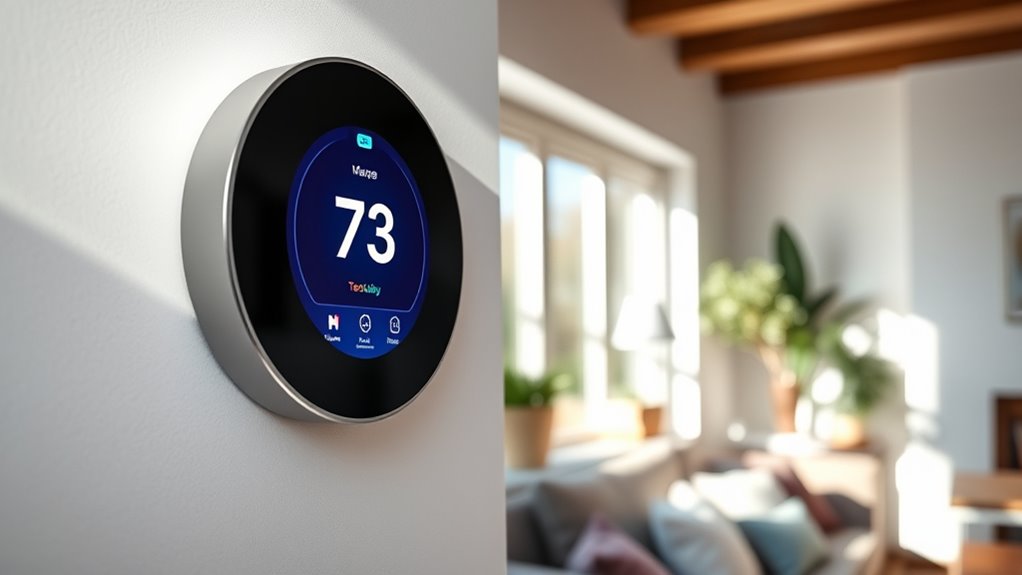
When managing short-term rentals, choosing the right smart thermostat can considerably boost guest comfort and streamline your property’s energy use. A well-selected thermostat not only guarantees your guests stay comfortable during their stay but also helps you manage energy consumption efficiently. With the right device, you can set ideal temperatures, avoid unnecessary heating or cooling, and reduce utility costs. This balance between comfort and efficiency is vital, especially when you’re handling multiple rentals or managing properties remotely.
Smart thermostats are designed to learn your preferences over time, so they automatically adjust settings to keep the environment cozy without wasting energy. For instance, if you notice that guests tend to arrive in the evening, you can program the thermostat to warm up or cool down the space just before they check-in. This proactive approach enhances guest comfort, making their stay more enjoyable from the moment they arrive. Many models also allow remote control via smartphone apps, so you can tweak the temperature if needed, even when you’re not physically present. This flexibility means you can respond quickly to guest needs and guarantee your property remains inviting without constant manual adjustments.
Smart thermostats learn preferences to automatically maintain comfort and energy efficiency.
When selecting a smart thermostat, consider how it integrates with your existing heating and cooling systems. Compatibility is key to maximizing energy efficiency, so double-check that the device works with your HVAC setup. Features like geofencing—where the thermostat detects when guests are approaching or leaving—can further optimize energy use by adjusting temperatures based on occupancy. This prevents energy waste when the rental is unoccupied. Additionally, look for models that offer detailed energy reports, so you can monitor usage patterns and identify opportunities to save more.
Ease of installation and user-friendly controls matter too. Guests should be able to adjust the thermostat easily without confusion, which can enhance their overall experience. Some smart thermostats include voice control options, making it even simpler for guests to set their preferred temperature with minimal effort. This convenience contributes directly to guest comfort, ensuring they feel at home.
Furthermore, as the use of automation and intelligent systems increases, the integration of AI in Education and other advanced technologies is transforming how properties are managed, offering new opportunities for efficiency and personalization. The combination of energy efficiency and enhanced guest comfort can lead to better reviews, higher occupancy rates, and lower operational costs. By choosing a device that aligns with your specific needs, you’re not just improving your rental’s appeal—you’re making your property smarter and more efficient in the long run.
Frequently Asked Questions
Can Smart Thermostats Be Controlled Remotely by Guests?
Yes, smart thermostats can be controlled remotely by guests, depending on their settings. Many models offer guest control, allowing visitors to adjust the temperature via a smartphone app or a dedicated interface. Remote access means you, as the host, can also manage the thermostat from afar, ensuring comfort and energy savings. Just make sure the thermostat’s settings are configured to permit guest control if you want them to have that convenience.
What Is the Typical Installation Process for Short-Term Rental Properties?
First, follow the installation steps by turning off power, removing the old thermostat, and wiring the new device. Check the hardware requirements to guarantee compatibility with your HVAC system. Connect the thermostat to Wi-Fi, secure it to the wall, and turn the power back on. Finally, configure settings through the app. This simple, step-by-step process ensures a smooth setup, saving you time and trouble.
Are There Compatibility Issues With Existing HVAC Systems?
You might face HVAC compatibility issues when installing smart thermostats, especially if your system has older or unique components. To confirm smooth system integration, check if your HVAC system is compatible with the thermostat’s features. Some models require specific wiring or system types, so verify compatibility beforehand. If you’re unsure, consult a professional to avoid potential installation problems and guarantee your smart thermostat works seamlessly with your existing HVAC setup.
How Do Smart Thermostats Impact Energy Costs in Rentals?
Smart thermostats can reduce energy costs in rentals by up to 15-20%, leading to significant energy savings and cost reduction. They optimize heating and cooling schedules based on occupancy, preventing energy waste. You’ll find that with smart thermostats, your rental becomes more energy-efficient, lowering utility bills and attracting eco-conscious guests. Overall, they’re a smart investment to help you save money while maintaining guest comfort.
What Security Measures Protect Guest Data on Smart Thermostats?
You protect guest data on smart thermostats by ensuring robust security measures like data encryption, which safeguards their privacy. Regularly update the device firmware to patch vulnerabilities, and use strong, unique passwords for access. Additionally, limit data sharing and monitor activity logs for suspicious behavior. These steps help maintain guest privacy, build trust, and prevent unauthorized access to sensitive information stored within your smart thermostat system.
Conclusion
Think of a smart thermostat as the captain of your rental’s comfort ship. With the right choice, you’re steering smoothly through guests’ stay, keeping everyone happy and your energy costs in check. Just like a skilled captain navigates unpredictable waters, selecting the right thermostat guarantees your rental sails effortlessly, providing warmth or coolness exactly when needed. Trust your instincts and choose wisely—your guests will thank you, and your bottom line will thrive.
